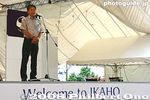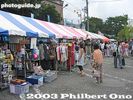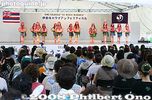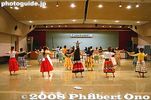Ikaho Merrie Monarch Hawaiian Festival 2008 伊香保ハワイアンフェスティバル
|
|
|

Main venue of the Ikaho Merrie Monarch Hawaiian Festival held every summer in Ikaho Spa, Gunma Prefecture since 1997. It is on a city-operated parking lot. 伊香保ハワイアンフェスティバル会場
|
|

The main venue has two large adjoining tents. The tent on the left covers the stage, and the one on the right covers the audience seats. The place is ringed by outdoor shops selling Hawaiian goods (mainly clothing).
|
|

About 600 seats at the main venue. Ikaho's connection to Hawaii lies with the summer residence of Robert Walker Irwin, the Hawaiian Minister to Japan during the late 19th century.
|
|

The Hawaiian festival's opening ceremony was held on the festival's first day on Aug. 3, 2008. Among Japan's many hula festivals, this one is unique since it is organized by a city government based on sister-city ties.
|
|

The opening ceremony included a few speeches and a ukulele performance by Mr. San'uemon Chigira, the chairman of the festival committee.
|
|

Short greetings by Luana Saiki-Kawelu, Assistant Director of the Merrie Monarch Festival in Hilo, Hawaii. Ikaho's Hawaiian festival is Japan's only hula event officially endorsed by the Merrie Monarch Festival in Hilo.
|
|

A few words by Kau'i Kamana'o, kumu hula of Hula Halau 'O Kamuela who was the festival's guest performer and overall winner of the 2008 Merrie Monarch Festival in Hilo, Hawaii.
|
|

Kumu hula Kunewa Mook also speaks at the opening ceremony. In the background is the flag of the city of Shibukawa. In Japan, all cities, towns, and villages have their own official logo and flag.
|
|

Kumu hula Aloha Dalire, instructor of the Hawaiian seminars during the festival, also greets the audience. アロハ・ダリレ
|
|

Thomas Goya, from Hilo and president of the Japanese Community Association of Hawaii, speaks as a representative of the County of Hawai'i, Ikaho's sister city. ハワイ島日系人協会会長
|
|

Tommy Hirano, Honorary Consul-General of Japan from Hilo, Hawaii also speaks. It was his first visit to Ikaho.
|
|

Signboard at the entrance to Ikaho Spa. ("Monach" is spelled wrong.) "Monach"はスペルミス。
|
|

Main venue of the Ikaho Hawaiian Festival. メイン会場
|
|

Shops around the main venue.
|
|

More shops on the lower level.
|
|

Shops on the lower level.
|
|

During Aug. 3-6, 2008, about 390 hula groups (totaling 4,700 people) performed on this stage. About 838 hula groups applied to perform, and only 390 could be selected to appear.
|
|

Every 4 minutes, a new group of hula dancers went on and performed on stage. This went on for four days 10 am to 6 pm (except on the first day when it started from 1 pm).
|
|

The first day featured Keiki Hula (hula by children).
|
|

Once upon a time, hula in Japan was mainly done by elderly women. Not anymore as hula's popularity has spread to all ages in Japan.
|
|

All the seats were filled during the all-day performances. So many hula groups applied to perform during the festival that Ikaho had to draw lots to decide who could appear.
|
|

For many women, hula is good exercise, recreational fun, or a chance to look and feel like a different person. The colorful costumes, flowers, attractive movements, and glamorous setting are all very appealing.
|
|

Kupuna 4分ごとに各フラチームがステージで出演。
|
|

The famous Stone Steps of Ikaho. Ikaho is on a mountain slope, and the Stone Steps goes through the center of the hot spring town. It is lined with shops and inns. ("Monach" is spelled wrong.) "Monach"はスペルミス
|
|

One section of the Stone Steps also served as another venue for Ikaho's Hawaiian Festival. 「街角フラ」石段にて
|
|

This venue is called "Machikado Hula." (Street corner hula). It went on from 11 am to 5 pm during the four-day festival (except on the first day when it started from 1 pm).
|
|

The audience sit on the Stone Steps to watch the "Street corner hula." So what did they do when it rained?
|
|

A few hula dancers take a break after performing their number on the Stone Steps.
|
|

A total of five 90-min. Hawaiian seminars were held during Ikaho's Hawaiian festival in Aug. 2008, and they were all taught by kumu hula Aloha Dalire who was very well received by the (thrilled) students.
|
|

Kumu hula Aloha Dalire explains that she is a 7th-generation kumu hula in her family, and produced five Miss Aloha Hulas at the Merrie Monarch Festival in Hilo, including all three of her daughters and Kuhi Suganuma, the 2008 Miss Aloha Hula.
|
|

Aloha Dalire taught seminars in hula history, Hawaiian expression, and lei-making (pictured here). She brought a boxful of a'ali'i flowers for lei-making. All the students had heard of the flower, but it was the first time for them to see it.
|
|

Aloha also taught two hula workshops. For the first workshop, she taught the song "Nani Lawa'i" (sung by Na Palapalai). First, she had the students close their eyes and listen to the song.
|
|

Aloha Dalire teaching hula in Ikaho. The Hawaiian workshops were held at the Ikaho Kaikan Hall in central Ikaho. アロハ・ダリレが教えるフラセミナー
|
|

For the second hula workshop, Aloha taught the song "Nani Manoa." The workshops were held at Ikaho Kaikan hall. 伊香保会館
|
|

It cost 30,000 yen to take all five seminars or 10,000 yen for one seminar. The hula seminars were the most popular. Free ukulele lessons were also taught at a different venue by a Japanese teacher.
|
|

Students who attended all five Hawaiian seminars were given a Certificate of Completion signed by Aloha Dalire who enjoyed teaching the seminars. She then freely signed autographs and took pictures with the students.
|
|

From 7 pm to 8:30 pm, the Hawaiian Waiwai Party allowed anybody to go up front and dance the hula. Hawaiian music provided by a Japanese Hawaiian band (Dan Yamamoto & Ikaho Hawaiians).
|
|

Hawaiian Waiwai Party ("Waiwai" means boisterous.)
|
|

After the Waiwai Party was a nightly drawing for prizes. People staying at any Ikaho inn/hotel would receive a lottery ticket which they put in this large box. The grand prize was a trip for two to Hawaii. The prize drawing was held on all four nights.
|
|

Guests of Honor from Hawaii were introduced to the crowd.
|
|

The nightly main event was an hour-long Merrie Monarch hula show by Hula Halau 'O Kamuela, the overall winner of the 2008 Merrie Monarch Festival held in Hilo, Hawaii.
|
|

Every year, the overall winner of the Merrie Monarch Festival is invited to perform at Ikaho's Hawaiian festival. They started with a hula kahiko (ancient hula) dance.
|
|

This was a song about paddling a canoe, I think.
|
|

Dreamy stage lighting.
|
|

Colorful costumes and lots of eye candy.
|
|

Crowd-pleasing performance.
|
|

Kumu hula Kau'i Kamana'o does a solo number.
|
|
|

On the last day of the festival on Aug. 6, 2008, a closing ceremony was held at 8 pm before the prize drawing and Merrie Monarch Show. Luana Saiki-Kawelu gives a few words.
|
|

Aloha Dalire also speaks during the closing ceremony.
|
|

Thomas Goya during the closing ceremony.
|
|

Tommy Hirano during the closing ceremony.
|
|

The Honorable Jiichi Kogure, mayor of Shibukawa, lauds the festival during the closing ceremony. 渋川市長 木暮治一
|
|

Mayor Kogure speaks with Aloha Dalire and Luana Kawelu after the Merrie Monarch Show.
|
|

On the last night of the festival, a farewell party was held for the Hawaii delegation. Shibukawa city council chairman Katsuaki Oshima (left) and Mayor Kogure pose with members of Hula Halau 'O Kamuela.
|
|

Members of Hula Halau 'O Kamuela try Japanese-style dancing during the farewell party.
|
|

Group shot of the Hawaii gang and Ikaho Hawaiian Festival Committee.
|
|

Hawaiian celebrities Aloha Dalire and Luana Kawelu pose with yet another group of Japanese hula dancers in a hotel lobby in Ikaho.
|
|
|
|
|
|